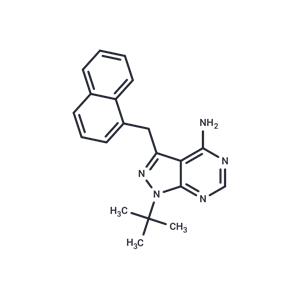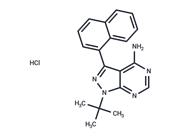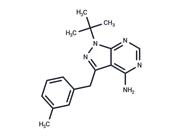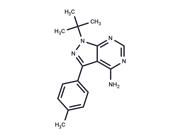| Name | 1-NM-PP1 |
| Description | 1-NM-PP1 (PP1 Analog II) is a cell-permeable PP1 analog that acts as a potent and selective inhibitor of mutant kinases over their wild-type progenitors. |
| Cell Research | 1-NM-PP1 (1-NMPP1) is dissolved in DMSO and stored, and then diluted with appropriate media before use[1]. Wild-type or Cdk7as/as HCT116 cells are synchronized by incubation in serum-free medium for 48 h and released into medium containing 10% fetal calf serum. Synchronization with thymidine or nocodazole, and analysis of cell-cycle distribution by flow cytometry, are performed. Cell viability is measured by MTT assay[1]. |
| Kinase Assay | Immunoblotting and immunoprecipitation, and kinase assays of immune complexes, are carried out. To measure Cdk1/cyclin B assembly, extracts (200 μg total protein) from cells in mitosis or G2 are pre-incubated with 2 μM 1-NM-PP1 or DMSO, then added 500 ng purified cyclin B1, amino-terminally tagged with hexahistidine and the Myc epitope, and an ATP-regenerating system. Where indicated, incubations are supplemented with 400 ng purified Csk1 or 600 ng wild-type or analog-sensitive, T-loop-phosphorylated Cdk7/cyclin H/Mat1 complex. After 90 min at room temperature, Myc-cyclin B and associated proteins are immunoprecipitated with anti-Myc antibodies and immune complexes are subjected to immunoblotting, with anti-Myc and anti-Cdk1 antibodies, and tested for histone H1 kinase activity[1]. |
| In vitro | Cdk7 from both mutant (Cdk7as/as) and wild-type (Cdk7+/+) cells was immunoprecipitated to assess its kinase activity on a Pol II CTD-containing fusion protein (GST-CTD) and human Cdk2. Interestingly, Cdk7 extracted from mutant cells, unlike that from wild-type cells, showed susceptibility to inhibition by 1-NM-PP1 (1-NMPP1), demonstrating an inhibitory concentration 50 (IC50) of approximately 50 nM for both substrates. Moreover, mutant HCT116 cells replaced with wild-type Cdk7 became sensitive to 1-NM-PP1, affecting growth. In the absence of 1-NM-PP1, both wild-type and mutant cells exhibited similar cell-cycle distributions and population doubling times (approximately 17.9 and 20.2 hours, respectively), indicating the F91g mutation alone minimally impacts Cdk7 function. However, mutant cells, but not wild-type, exhibited sensitivity to 1-NM-PP1 with an IC50 of approximately 100 nM, as determined by cell viability (MTT) assays after prolonged (96-hour) exposure. Additionally, 10 μM of 1-NM-PP1 hindered G1/S phase progression in mutant but not wild-type cells, with immediate effects observed when 1-NM-PP1 was introduced alongside serum, halting S phase entry for 15 hours. Even after releasing the mutant cells from serum starvation into a medium with 1-NM-PP1, there was a delayed and partial progression into S phase, while a fraction remained in G1. Further experimentation revealed that introducing 1-NM-PP1 3 or 6 hours post serum addition delayed S-phase entry by approximately 7 and 3 hours, respectively. |
| Storage | Powder: -20°C for 3 years | In solvent: -80°C for 1 year | Shipping with blue ice. |
| Solubility Information | DMSO : 45 mg/mL (135.78 mM)
|
| Keywords | inhibit | Inhibitor | 1-NM-PP-1 | Src | 1NMPP1 | 1-NM-PP1 | 1 NM PP1 |
| Inhibitors Related | Ribociclib | Nintedanib | Ibrutinib | Dasatinib | Camostat mesylate | CASIN | Palbociclib | Sodium Oxamate | Abemaciclib | Benzamidine hydrochloride | Dinaciclib | Abemaciclib methanesulfonate |
| Related Compound Libraries | Anti-Pancreatic Cancer Compound Library | Bioactive Compound Library | Tyrosine Kinase Inhibitor Library | Kinase Inhibitor Library | Inhibitor Library | Metabolism Compound Library | Anti-Aging Compound Library | Bioactive Compounds Library Max | Cell Cycle Compound Library | Anti-Cancer Compound Library |

 United States
United States



